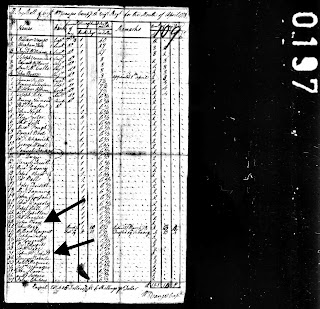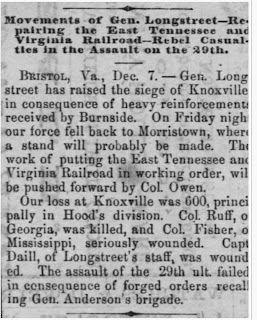An impassioned researcher goes beyond the list of names with births and death dates to learn more about their ancestors. Let’s dig for some details using the life story feature on Ancestry.com on my fourth great-grandfather, John Ogan. I am sharing the short biography that is auto-generated from information I have inputted on his profile using censuses, land documents, court testimony, and wills:
John Ogan was born in 1770 in Frederick County, Virginia. He married Hannah in 1798. They had three children during their marriage. He died on May 12, 1834 in Grainger, Tennessee, at the age of 64.
An interesting fact from Virginia history via Ancestry’s life story feature shares a historical event that occurred during John's childhood -- Lord Dunmore’s War. This was a 70-year dispute between the colonists and the Native Americans that resulted in a declaration of war in 1774 in the Virginia Colony. The dispute was over hunting and property rights along the Ohio River. The guns and muskets of the militia forced the Native Americans to surrender to John Murray, Lord Dunmore on October 10, 1774.
 |
| Credit: US Map Collection, 1513-1990/Ancestry.com |
This makes one realize that young John lived in a tumultuous time as our country's inhabitants struggled to survive. There was also talk of establishing its independence from the Great Britain and another suggestion on his life story was Thomas Paine’s Common Sense. This gives me insight into how his writing inspired the colonists to embrace that independent spirit and make a break from the King's rule, “…the same tyranny which drove the first emigrants from home, pursues their descendants still….”
 |
| Source: Ancestry.com |
Just think that at the age of about six years, young John would overhear adults talk of the Declaration of Independence! It’s amazing to think how this news was dispersed to the colonies. Perhaps they gathered in the town square to be given this information. What an amazing time to grow up in this country!
By 1799, John was married to Hannah (unknown maiden name) and their first son was born in Tennessee. His was named Peter and he married Hannah Wolfe. The couple would also have a daughter named Phanny or Phama (it seems to vary in documents) who was born about 1803 who married John Epperson and they are my third great-grandparents. Another son named John Jr. was born about 1805 and married Catherine Wolfe who is said to be a sister to his brother’s wife. After John Jr.’s death, Catherine married Benjamin Bray, Jr.. These are the only proven children I have documented.
While researching this topic, another discovery was made in that John Ogan was the bondsman in the marriage of Richard Bull and Fanny Bray in Grainger County on May 11, 1805 so I will need to research this couple to see how they connect to the Bray line. Moving further into time, John becomes a landowner in Grainger County on December 26, 1815 for 260 acres and acquires 200 additional acres on November 7, 1816. His son, John Jr. dies in 1826. In 1830, John and his wife are enumerated on the Grainger County census.
Another life story states he may have witnessed one of the most spectacular meteor showers in history on “the night the stars fell.” The event took place on November 12, 1833 where 150,000 meteors blazed through the sky. Some Southern religious groups believed this was a sign of the End of Days due to the biblical verse – “and the stars of heaven shall fall.” Given that his son, Peter, was a Methodist minister then I wonder how they perceived this event.
 |
| Source: National Banner and Daily Advertiser (Nashville, TN) 25 Nov 1883, p. 3 |
Now the most amazing thing happened during the course of my research, John Ogan appeared in a search in Fold3 in conjunction with John McDonald aka McDaniel aka McDonough. This was a separate application for John McDaniel's Revolutionary War pension made by his wife, Margaret McDaniel. In it she states they were from Frederick County, Virginia. John Ogan and Peter Wolfe were character witnesses on a document dated March 25, 1834. John's testimony reveals he has known my fourth great-grandfather, John McDaniel for 50 years or so. John Ogan stated his uncle served in the Revolutionary War with John McDaniel and considered him a very brave man. I believe the uncle he referred to was named Thomas Ogan whose Revolutionary War service is very well documented. More research awaits me!
On May 12, 1834, John departed this life intestate and the following is the transcribed probate paperwork:
County Court May session 1835: To the Worshipful Court of Pleas vc. for said County now sitting. The petition of Polly Mariah Ogan by her guardian Benjamin Bray and John Epperson & his wife Famey, formerly Famey Ogan, respectfully represents to your worship that about the 12th day of May, 1834, John Ogan sen. departed this life in Grainger County without having made any last will and testament leaving your petitioners, Polly Mariah, who represents her deceased father, John Ogan Jr., the said Famy, formerly Famey Ogan, and Peter Ogan, his heirs at law. That he died seized and possessed of the following described tract of land lying in the County of Grainger aforesaid to wit: no. 4044, dated the 7th day of Nov. 1818, forteen acres, lying in sais County on the waters of Clinch River on the South side of the River Ridge, beginning at a black oak and white oak the beginning corner of said Ogan's former entry of no. 1052 thence with said line south twenty siz east ninety nine poles to a large white oak hickory south sixty-two west seventeen poles to a white oak ____ tree north twenty-seven west ninety-nine poles to a poplar and dogwood north sixty-two east sixteen poles to the beginning -- also one other tract conveyed by Thomas Johnson by his attorney in fact Asabel Johnson, by deed bearing date the 15th day of Nov. 1818, to the said John Ogan, containing forty-eight acres, situate in the County aforesaid, lying on the waters of Clinch River and bounded by lines beginning on the north side of the War Ridge, near the said John Ogan's fence on the big survey line, granted to James King, running then on with the said big survey Line -- thence north forty degrees west one hundred & thirty-eight poles to a sugar tree, ___ & Spanish oak on the bank of Clinch River, corner to the said big survey thence south seventy-eight degrees east and one hundred twenty poles to two beech trees -- thence south thirty-seven degrees east twenty six poles to woc & sugar tree -- thence north seventy-six degrees east, thirty poles to a stake -- thence south thirty degrees east thirty-six poles to a stake -- thence direct to the beginning. Also one other tract granted by the State of Tennessee by grant no. 3723-- bearing date the 26th day of December 1815, lying on said county, and containing sixty acres, on the waters of Clinch River on the south side of the River Ridge beginning at a black oak and white oal John Web Roaches corner -- then with his line south twenty six east eighty poles to a white walnut & ash on the side of the War Ridge -- then north sixty eight East eighty poles to an elm in a sinkhole and a beech -- then north eighty five east sixteen poles to a buckeye and beech then north fifty west ninety five poles to a beech on the River Bluff then north fifty west along the Bluff ninety four poles to a white oak then south twenty two west sixteen poles to a stake then south twenty six east sixty five poles to the beginning. Also one other tract containing about three hundred acres lying partly in Hawkins & partly in Grainger apart of which was conveyed to said John Ogan by Thomas Johnson by Asabel Johnson his attorney in fact for the boundaries whereof reference is had to said deed of conveyance, the balance by grant from the State of Tennessee -- that the said John Epperson has bought of the widow of said John Ogan her right to dower to all of said lands and holds her deed for the same and the said John Epperson has also purchased of the said Peter Ogan his entire interest in the three first described tracts of land & holds his conveyance for the same. Your petitioners pray your worship to appoint five commissioners to partition & lay off said lands among the claimants pursuant to this petition & the laws of the land and to lay off the dower aforesaid to Jno. Epperson and as in duty bound we will ever pray -- Benjamin Bray, John Epperson & his wife Famy Epperson.
Thus ends another ancestor's story but one in which rewarded me with new twists and turns.
"When our hearts turn to our ancestors, something changes inside us. We feel part of something greater than ourselves. Our inborn yearnings for family connections are fulfilled when we link to our ancestors..." Russell M. Nelson

















